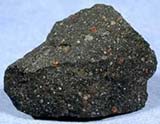Shooting stars sugar coated

The Murray meterorite and others may have seeded life on earth. <br>© New England Meteoritical Services <br>
Meteorites could have sweetened the earliest life.
Sugar from space may have nourished the first life on Earth. Two meteorites contain a range of polyols, organic substances closely related to sugars such as glucose1.
George Cooper of NASA’s Ames Research Center in California and co-workers have found these compounds in the Murchison meteorite, which fell over the Australian town Murchison in 1969, and in the Murray meteorite, that fell to Kentucky in 1950.
Both of these carbon-rich meteorites are thought to be fragments of asteroids, rubble from the building of our Solar System. The Murchison meteorite has been particularly well studied. That it contains amino acids, the molecular building blocks of proteins, helped to establish that these basic components of life’s molecules can be formed in extraterrestrial environments.
This implied that life on Earth might have been seeded by organic compounds falling from the skies, rather than having started from scratch on the young planet. The meteorites’ sugar molecules hint that another essential building block of life may have come from space.
Sugars form part of the backbone of the molecules DNA and RNA, found in all living organisms. They are also life’s primary energy store. Polyols, close chemical relatives of sugars, are used commercially as sugar-free sweeteners such as sorbitol and mannitol.
Cooper’s team found a wide range of polyols in the two meteorites, and some related molecules called sugar acids. The group also spotted one of the simplest pure sugar molecules, dihydroxyacetone.
Sugars were reported in Murray and other meteorites in the 1960s – including glucose, the main sugar made by plants during photosynthesis. But there was a strong possibility that these compounds might have been incorporated into the meteorites by microbial contamination on Earth.
The compounds seen by Cooper and his colleagues are less likely to be terrestrial contaminants because, in the main, they correspond to substances not found in living organisms. Moreover, the relative abundances of different polyols match what would be produced by chemical rather than biochemical processes.
The researchers think these cosmic sweeteners might have been formed in reactions between formaldehyde and water on the asteroid parent bodies of the meteorites. Formaldehyde, a very simple organic molecule, forms in interstellar space by reactions of still simpler molecules such as carbon monoxide.
The findings therefore support a growing realization that, even in the frozen depths of space, lifeless chemistry can arrange the elements into molecular forms well along the road to primitive life.
References
- Cooper, G. et al. Carbonaceous meteorites as a source of sugar-related organic compounds for the early Earth. Nature, 414, 879 – 883, (2001).
Media Contact
More Information:
http://www.nature.com/nsu/011220/011220-11.htmlAll latest news from the category: Life Sciences and Chemistry
Articles and reports from the Life Sciences and chemistry area deal with applied and basic research into modern biology, chemistry and human medicine.
Valuable information can be found on a range of life sciences fields including bacteriology, biochemistry, bionics, bioinformatics, biophysics, biotechnology, genetics, geobotany, human biology, marine biology, microbiology, molecular biology, cellular biology, zoology, bioinorganic chemistry, microchemistry and environmental chemistry.
Newest articles

NASA: Mystery of life’s handedness deepens
The mystery of why life uses molecules with specific orientations has deepened with a NASA-funded discovery that RNA — a key molecule thought to have potentially held the instructions for…

What are the effects of historic lithium mining on water quality?
Study reveals low levels of common contaminants but high levels of other elements in waters associated with an abandoned lithium mine. Lithium ore and mining waste from a historic lithium…

Quantum-inspired design boosts efficiency of heat-to-electricity conversion
Rice engineers take unconventional route to improving thermophotovoltaic systems. Researchers at Rice University have found a new way to improve a key element of thermophotovoltaic (TPV) systems, which convert heat…



